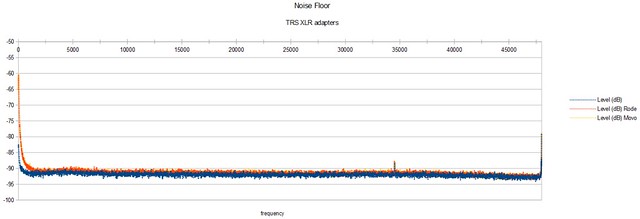TRS to XLR Adapter Noise Floor
Written 2021-12-30
Tags:microphone XLR audio
Today I take a look at the noise floor of my Tascam DR-44WL with a couple phantom power XLR to plug-in power TRRS microphone adapters.
Test Setup
Tascam DR-44WL set away from other electronics and recorded with no adapter, and again with each adapter in XLR port 1 with 48V phantom power. No input termination was used. The recorder was set for +15dB gain, the most sensitive setting.
Analysis and Results
All three recordings were run through a 16k point spectrum analysis in Audacity, then each spectrum exported and combined in OpenOffice Calc. This first plot has a linear frequency horizontal axis.
The first thing I noticed was a slight peak around 34.5KHz, but I would never hear it, and it's present without the adapters so it's either inside the recorder or around my home. Also note that the orange(Rode) and yellow(Movo) curves overlap nearly exactly, and are both higher than the blue curve(no adapter).
If we rescale the horizontal axis with a log scale, we can see the effect of the added noise of the adapters at 20Hz can be 20dB worse than without one, but the difference rolls off as we go up in frequency. Really though, these are likely to be combined with a low-cut filter for voice recording.
Tomi Engdahl has a good write-up on plug-in-power and a few different designs for how these adapters work, if you scroll to "Balanced electret microphone circuit" it is quite similar to what Zach Poff found.
Initially, I was concerned these adapters were going to add a lot of wideband noise, as that's what Zener diodes emit. However, there's a little more going on here. The actual impact to noise floor is both lower than I had suspected, but still a little disappointing that it reaches up into the voice band.
First, the tantalum capacitor in parallel with the Zener diode does a lot to filter out noise. The choice of tantalum here may be important, as electrolytic capacitors tend to have higher ESR than tantalum, and more ESR would limit ability to filter noise here.
Second, the Zener diode is powered from the XLR audio+ and audio- lines through a pair of resistors. Because XLR is differential, and similar amounts of Zener noise should flow back through both resistors, most of the Zener noise seen through the XLR should be common-mode and thus easy to reject.

